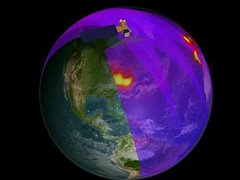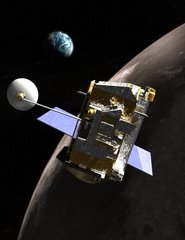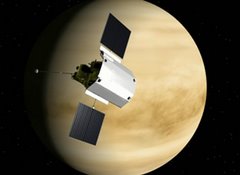
I thought we would change directions today and look at a phenomenon found here on Earth, glaciers. I'm not saying one might not find glaciers or remnants of glaciers on other planets such as Mars, but most people relate glaciers to the Earth.
Whether it is Greenland or Antarctica, glaciers have been in the news. Scientists have been keeping track of glacial movement for some time. It is possible to see how glaciers of thousands to million years ago have changed the landscape of continents. Some examples can be seen in the northern portions of North America, Europe, and Asia. So how do glaciers move?
The University of Maine's
Department of Geological Sciences and Climate Change Institute has created a model of Malaspina glacier. Leigh Stearns and Erich Osterberg, of U of  Maine, used Flubber to assist them in the modeling of this glacier, see image to the left. But why use Flubber?
Maine, used Flubber to assist them in the modeling of this glacier, see image to the left. But why use Flubber?
Flubber has a unique properties very similar to that of ice. If you slowly pull on it, it will flow like ice does in a glacier. It also shears like ice when quickly pulled apart. Ice deforms plastically most of the time – that's what allows it to flow. When brittle failure occurs, crevasses open up.
Also, just like ice, Flubber flows more quickly when it is either warm or on a very smooth surface, and slows down when it's cold or on rough surface.
Your students can use Flubber to model glaciers and see how the different variables, temperature, surface roughness, and incline, can make a difference in how Flubber flows.
Materials: One recipe of 'Flubber'
| Mix #1
3/4 cup of warm water
1 cup of white glue
food coloring (optional) | Mix #2
2 tsp of Borax
1/2 cup of warm water
|
Procedure:
Simply combine the two mixtures and work through the hands for several minutes until a consistent texture results. Drain any excess water. Flubber is easy to make and fun to work with and does not stick to hair or skin once formed (glue may stick to hands while working the Flubber to its correct consistency), however the Borax and glue are toxic and should not be ingested. We therefore advise against allowing young children to play with Flubber unsupervised. Flubber can be stored for several weeks in an air-tight bag (e.g. zip-lock). Simply rework some warm water into the Flubber to return it to a desired consistency.
Material:
- 2 (or longer) foot-long section of 4” PVC pipe, cut in half lengthwise, to simulate a valley
- 3-4 recipes Flubber (of at least 2 different colors)
To examine the properties of ice in a glacier form, flatten out the Flubber from a round lump into a flat pancake. In one section of the PVC pipe, lay the flattened out Flubber block into the top of the ‘valley’ using alternating colors, such as green and white. The alternating colors visually accentuate velocity gradients during flow. You can incline the pipe and see how fast the Flubber flows. Note that the flow is slower near the sides of the pipe because of friction from the valley walls.
To expand on the initial experiment, a comparison of flow can be done with a variety of materials on the pipe. An example is you can wet the pipe (the Flubber should flow faster because of less friction). Or you can make a continent out of clay or papier maché including mountains, cover it with plastic wrap or foil and then try the 'Flubber'. Another variation is comparing the viscosity of the Flubber at different temperatures. You can put one lump in the freezer for a while and compare how fast it flows compared to a warmer piece of Flubber (warm ice deforms more easily than cold ice). You should test different temperatures of ice (Flubber), different ‘valley’ slopes and basal conditions. To determine the velocity, make sure you measure (with a ruler) how far the Flubber moves in a given amount of time.
Velocity Table:
| | Blue (cold) | White
(normal) | Red (warm) |
| Sandpaper
PVC | Dist:
Time:
Velocity: | Dist:
Time:
Velocity: | Dist:
Time:
Velocity: |
| Normal
PVC | Dist:
Time:
Velocity: | Dist:
Time:
Velocity: | Dist:
Time:
Velocity: |
| Lubricated
PVC | Dist:
Time:
Velocity: | Dist:
Time:
Velocity: | Dist:
Time:
Velocity: |
| | Blue (cold) | White
(normal) | Red (warm) |
| Slope -
shallow | Dist:
Time:
Velocity: | Dist:
Time:
Velocity: | Dist:
Time:
Velocity: |
For more information, please visit:
http://www2.umaine.edu/USITASE/teachers/activityideas.html
http://www.geology.um.maine.edu/geodynamics/AnalogWebsite/Projects2003/Sterns_Osterberg_2003/index.html




























